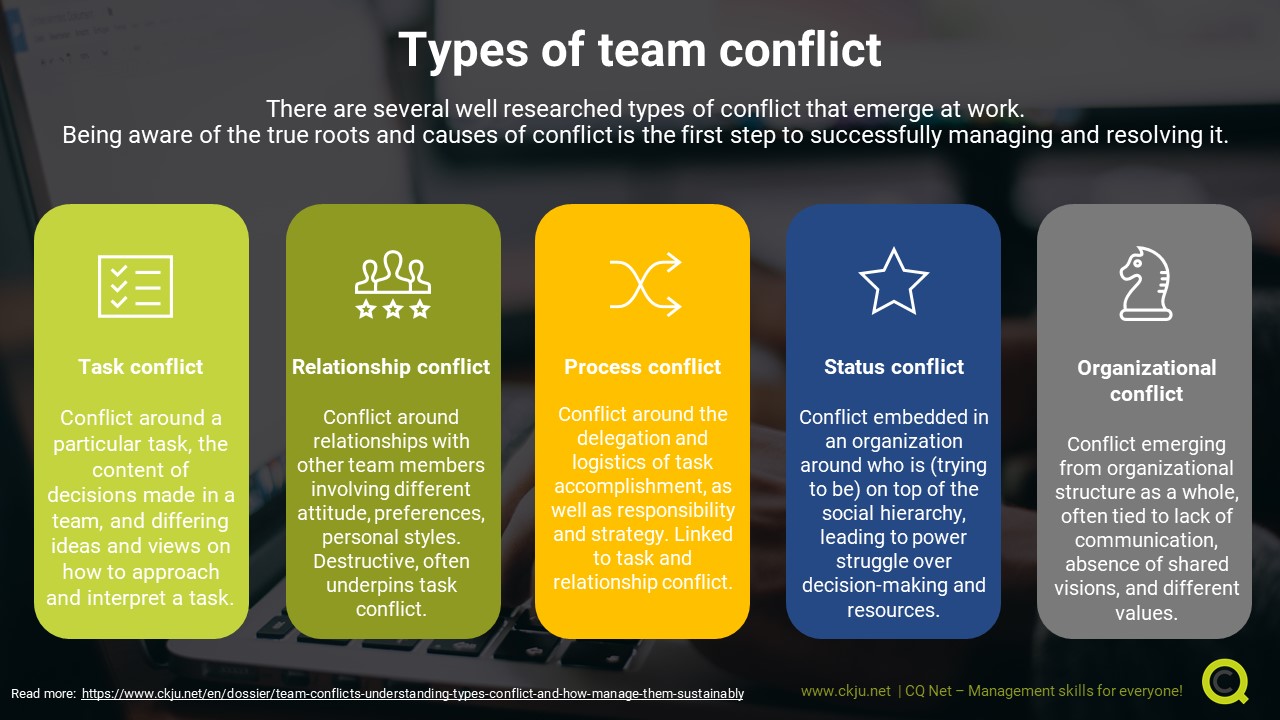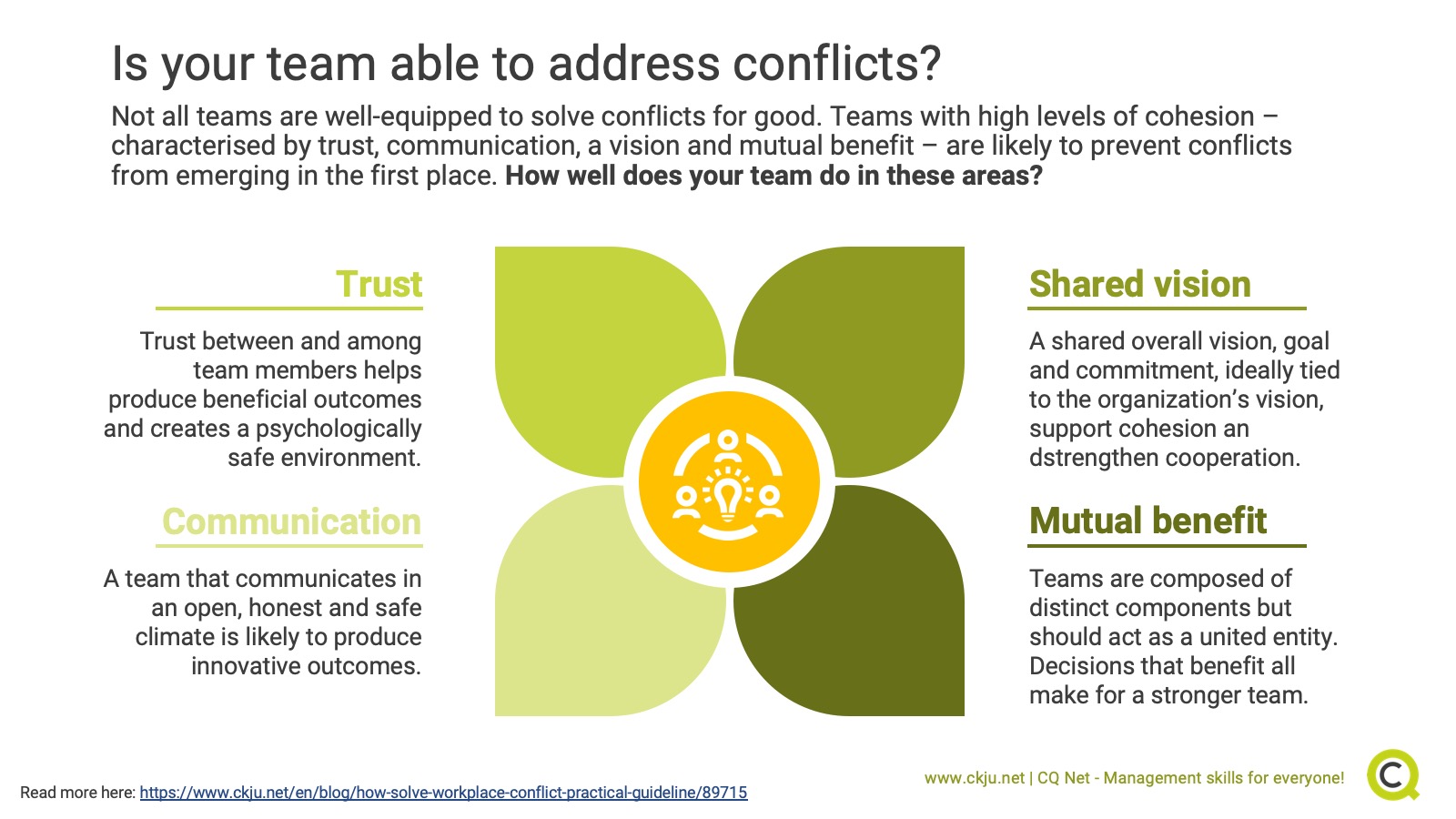- Blog
- How to solve workplace conflict
Contents
- Conflict is an inevitable part of any workplace
- Step 1: Admit you face a conflict that has to be addressed
- Step 2: Determine the cause of the conflict
- Step 3: Determine whether the team is able to address the cause
- Step 4: use the right strategies to resolve conflict for good
- References and further reading
Conflict is an inevitable part of any workplace
In any healthy relationship, conflicts arise. While some say this helps blow off steam, others say it is helpful because it mends people closer together. The same logic can be applied to conflicts in teams at the workplace. When people work together on tasks, the true variety of all styles, personalities, beliefs, values and ways of working collide. When workplace conflict arises, it is important to address it and to overcome it. The following step-by-step approach will help you to identify, address and overcome workplace conflicts in a constructive way.
Please note: this guide is not a magic formula holding guaranteed solutions but rather a collection of research insights that may or may not be useful in your situation.
Step 1: Admit you face a conflict that has to be addressed
This may seem obvious, but often tensions arise and underlying friction grows without and recognition for the fact that it could be a conflict. Acknowledging a conflict has a distinct advantage: naming it as a conflict paves the way for conflict resolution. Conflict resolution is not a clear-cut goal: successful resolution means avoiding the conflict from arising again in the future, not merely making the conflict go away. As such, admitting to a problem means committing to a process of hard work, communication, self-reflection and compromise.
A conflict is more than an insignificant disagreement
A conflict in this post does not refer to small and insignificant disagreements or passing grievances. Rather, a conflict is a truly bothersome disagreement, clash of values or working styles, or a bigger, more long-term and underlying issue that impacts all aspects of work and cannot be solved by simply waiting for the next day to come.
Example:
A team of five people from sales, product management and commercial works closely together to win a customer over for a big investment project. During a meeting dedicated to preparing how to approach the customer best, the team members can’t agree on how the product presentation should be organized and structured. As the discussion heats-up, two team members get into an argument that goes beyond the task to be solved. You are the project leader and jump in to get the discussion back on track. One day later one of the two team members is on sick leave. You start to worry whether there is a relationship between the team conflict and the sick leave.
Step 2: Determine the cause of the conflict
Not every conflict is born the same. Research shows there are at least three different types of conflict:
- Task conflict: relating to the tasks a team is given, the decisions made around it, ways of understanding the task, etc.
- Relationship conflict: relating to the people in the team, interpersonal styles and attitudes, personality, etc.
- Process conflict: relating to how tasks are delegated, how tasks are solved, the logistics of task division and responsibility, etc.
Beyond these three types, there are several more pertaining to even more underlying causes like structure of the organization or conflict relating to struggles over status and power.
Determining the cause of the conflict helps think about how to best address it, and helps disentangle conflicts arising in day-to-day interactions from underlying issues that need to be addressed. Is it really task division that is bothersome, or is it the attention-seeking attitude of the colleague that is the issue?
Broadly speaking, this is an exercise in situational awareness: taking a step back and seeing how different pieces of the puzzle interact to figure out where the problem is. As a management tool this is crucial: it helps avoid similar situations in the future, and it boosts learning in teams (see Brady et al. 2013).
Don't expect to find one root cause of the conflict
Please keep in mind that you will most probably not find one root cause of conflict but different explanations. This is natural, as all involved parties see the conflict from a different perspective. For you it is important to get to know those different perspectives and to understand the big picture. Once you listen to all involved parties and appreciate their version of the story, you have already taken an important first step to addressing the conflict. When you try to convince them that there is one "truth" (or root cause) that underlies the conflict you risk to get caught in the conflict yourself and hamper your efforts to solve it.
Example:
Having talked to each team member individually about how the meeting went, you are pretty sure that the team is on conflict mode. Your perception for the face-to-face interviews is that you have to deal with two types of conflict. One the one hand there are team members that don’t agree how the decision was made regarding the product presentation. On the other hand you got the impression that the two team members who got caught in the argument are in the midst of a relationship conflict on top of the task conflict the team as a whole faces.
Step 3: Determine whether the team is able to address the cause
This is perhaps the most crucial step in this guide: not every team is the same and not every team is well-suited to address problems. Research shows that team dynamics - the way teams behave and the processes that underlie these actions - and especially team cohesion - the team bonding that occurs between members - are integral in successful conflict management.
Successful, high-performing and sustainable teams are social in nature with team members having high task interdependency and shared, common values (Salas, Cooke & Rosen, 2008). In other words, whether the team will be able to solve the conflict and address the underlying issues strongly depends on the team itself.
How can one determine whether a team is well-equipped to solve conflicts for good?
Here are some questions you could ask:
- Is there trust among team members?
- Do team members share the same long-term goals?
- Do team members share the same values?
- Are team decisions made in the interest of all team members?
And - the most important questions:
- how well does team communication work?
- Is communication honest and open?
- Is the team a safe environment, also for vulnerability and/or failure?
Team cohesion is an important requirement to overcome conflicts
If the answer to these questions is mostly yes, there is a high likelihood the team has high levels of cohesion. Research shows cohesive teams make decisions that are pre-emptive, holistic, and beneficial to everyone (see Behfar, Peterson, Mannix and Trochim, 2008). There is also a high likelihood that Team Mental Models are at play - the idea that all members are “on the same page” and have a shared understanding of elements needed to achieve positive outcomes (Mohammed et al., 2010). Congratulations, with a cohesive team it is possible to proceed to step 4.
Dig deeper when you cannot find a starting point to address the conflict
If the answer to these questions is mostly no, then unfortunately the chance that the team can effectively solve the conflict without the same conflict arising again in the future is rather low. While the conflict and the underlying cause could be addressed, this would most certainly not lead to long-term outcomes. On the contrary, stifling conflict, ignoring it or simply giving in to any solution could make it erupt even worse the next time around.
When the team itself is not cohesive, there is likely a much bigger issue behind the conflict and its underlying causes. Once recognized, this bigger problem definitely should be addressed before focusing too much on smaller conflicts that arise in day-to-day interactions.
- Is the team hierarchical even though it should be horizontal?
- Perhaps organizational culture is toxic and does not allow for teams to grow?
- Maybe no effort has been made to build team dynamics?
- Is there a lack of leadership or supervision?
- Are team members lacking the will to be part of the team in the first place?
- Is there a shared mission or vision?
To address such fundamental concerns, it makes sense to seek outside advice from supervisors, moderators, coaches, or peer mediators who could help establish communication about these fundamental issues and help find solutions. Also, it makes sense to ask for team development interventions. There are several ways to improve team effectiveness, for example simulation training, team-building, leadership training, or Crew Resource Management (CRM) training.
Take a look at out CQ Dossiers to learn more about how to improve team communication and team effectiveness. In addition, you can also make use of our counseling support.
Example:
The team has been working together on complex sales projects before and performed well. This makes you convinced that it might even be enough just to bring the team again on the table and openly address the task conflict. The trickier part will be to solve the relationship conflict between the two team members. As you know both team members well, you decide to give it a try and solve the conflict by your own without asking for outside help.
Step 4: use the right strategies to resolve conflict for good
Contrary to popular belief, there are no step-by-step guides that guarantee a solved conflict. Rather, there is a collection of best practices and good methods that help reach goals that are beneficial to all team members alike and can help resolve the issue(s) and address the underlying causes.
Solving a team conflict is a process rather than a single event
Indeed, the criteria for “resolving” conflict should include upholding and promoting the shared vision, including all team-members in the decision, benefitting all team-members, and helping to create a safe environment for new ideas. These are basic cornerstones of team efficacy and help mobilize effort to perform well as a team (Gibson, 2003).
Keeping in mind this framework, best practices to resolve conflict without having it arise again include:
- speaking honestly
- listening openly
- don't get caught in the conflict yourself
- practicing no judgement
- seeking compromise
- offer solutions
- practicing empathy and understanding
- looking ahead to shared outcomes
These soft skills see the unified entity of a team in the foreground. While it is no doubt the sum of its parts, a team is its own little environment that merits a safe space, friendly and warm culture, and a commitment to common goals. As such, a team is like a small organization or a functioning relationship.
Example:
Your approach to tackle the task and relationship conflict is two-fold. First, you’ll invite for another team meeting where you openly address the conflict, the importance of the project, and the team’s track record of delivering high performance. You also point out that you are sorry when you pushed too hard to find a solution in the last meeting. After a short introduction that discussion gets traction and you finally the team comes-up with a mutually agreed solution AND lessons learned on how to avoid such a conflict in the future.
Second, you’ll ask for one-on-one meetings with the two team members that are in the midst of a relationship conflict. After you asked them what went wrong from their point of view, you point out that it is important to find a way forward and overcome the issue. You suggest a six-eyes meeting where both team members address their side of the story and you act as neutral moderator. However, before the discussion starts, you introduce a set of discussion rules and state your expectation for the meeting. As you know that it will be hard to fully solve the relationship conflict, you emphasize that the meeting is not about “finding the truth”, but finding a way forward.
When these best practices are used, there is a high chance that team trust, cohesion, efficiency and performance will grow, molding the team together even more and preventing conflicts from arising in the future.
References and further reading
Brady, Patrick W.; Muething, Stephen; Kotagal, Uma; Ashby, Marshall; Gallagher, Regan; Hall, Dawn et al. (2013): Improving situation awareness to reduce unrecognized clinical deterioration and serious safety events. In Pediatrics 131 (1), e298-308. DOI: 10.1542/peds.2012-1364.
Behfar, K. J., Peterson, R. S. [Randall S.], Mannix, E. A., & Trochim, W. M. K. (2008). The critical role of conflict resolution in teams: A close look at the links between conflict type, conflict management strategies, and team outcomes. The Journal of Applied Psychology, 93(1), 170–188.
Salas, E., Cooke, N. J., & Rosen, M. A. (2008). "On Teams, Teamwork, as well as Team Performance: Discoveries and Developments". Human Factors: The Journal of the Human Factors and Ergonomics Society. 50 (3): 540–547.
Gibson, B. C. (2003). The efficacy advantage: Factors related to the formation of group efficacy. Journal of Applied Social Psychology, 33, 2153-2186.
Mohammed, Susan; Ferzandi, Lori; Hamilton, Katherine (2010): Metaphor No More. A 15-Year Review of the Team Mental Model Construct. In Journal of Management 36 (4), pp. 876–910. DOI: 10.1177/0149206309356804.
Top Rated
About the Author

Comments
Most Read Articles
Blog Categories
RELATED SERVICES











Add comment